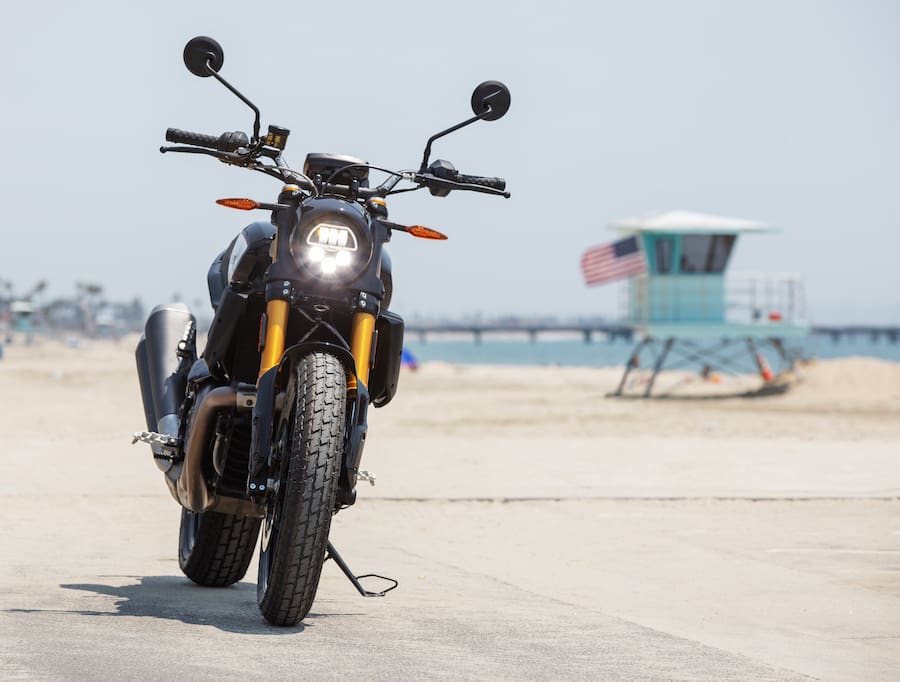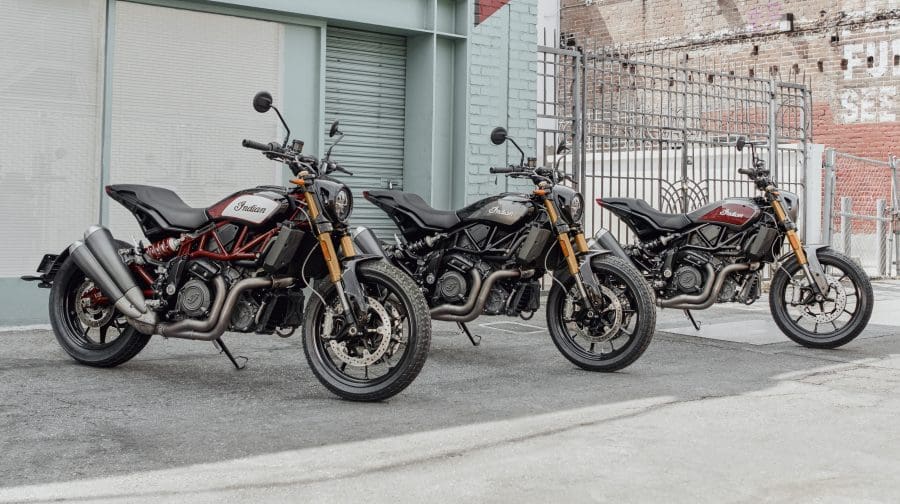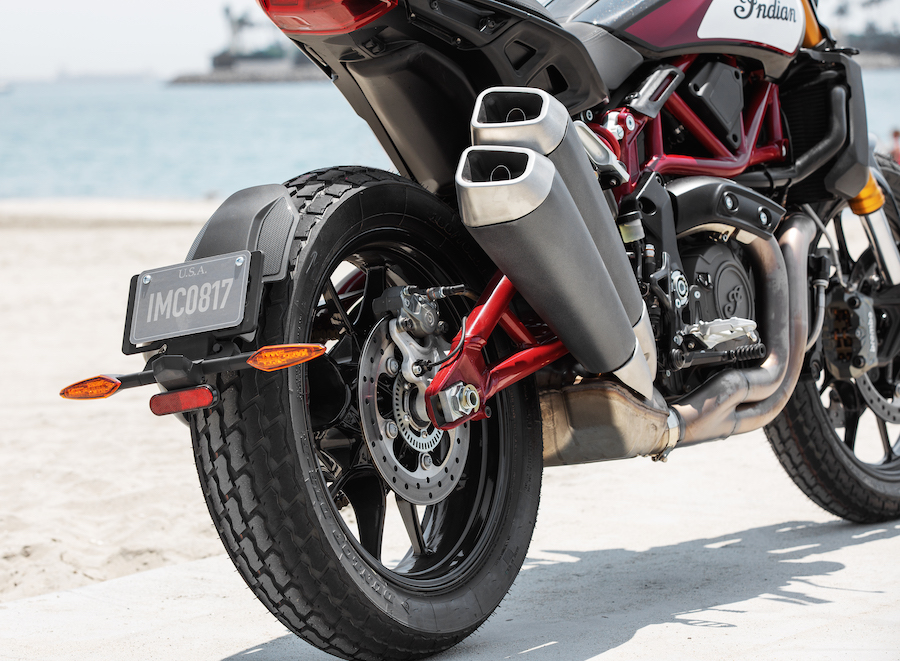It had to happen. After Indian Motorcycle’s two full seasons of utter supremacy in the 2017-18 American Flat Track (AFT) racing seasons after a 70-year absence from racing – winning 17 of the 18 races held in the 2018 season – America’s oldest motorcycle manufacturer has finally launched a road-legal spinoff of that title-winning racer.
Clearly inspired by the successful FTR 750 in terms of both styling and engineering, the base model 2019 FTR 1200 broke cover at Germany’s Intermot Show on 1 October, and will in inevitably usher in a series of street trackers from several other manufacturers, none of which however has such a proud history of race success as Indian. Okay, Harley already tried it with the relatively short-lived XR1200 back in 2008, but perhaps a decade before its time, and nothing since.
The FTR machines are the real deal, and an exclusive ride on the pre-production prototypes on the roads of Minnesota and Indian’s test track six weeks before their Intermot launch, revealed these will be the first of several future Indians to be powered by the FTR’s all-new liquid-cooled 1203cc 60º V-twin engine. Delivering a claimed 90kW (120hp) at 8250 rpm, with 115Nm of torque peaking at 6000rpm, this is the third Indian engine platform under Polaris ownership. It follows the Chief and Scout mills, but shares little beyond a general overall format with the Scout motor it’ll inevitably be compared to, says Indian CEO Steve Menneto.
“It’s a totally different engine than what the Scout’s is,” Menneto said. “And I think you could say that it’s a very flexible platform for us to go forward with. It’s exciting how we’re going to stretch Indian way beyond Cruiser/Bagger/Tourer – and the FTR1200 is a perfect example of how that’s going to happen.

“Our focus is about Indian becoming a global brand. And for us to be a credible such brand, we know that we have to enter the European market with great motorcycles that are tailored towards what customers in those countries are looking for.”
So while rather ironically this new donk is making its debut in something as quintessentially American as baseball, its future will see it powering models aimed at a world audience, with an adventure tourer to rival the BMW R1250GS likely to be up next, then maybe a streetfighter, or sports tourer – take your pick. Menneto clearly envisages Indian as a global brand, not merely a producer of modern American-style V-twin motorcycles, however excellent, and this engine is the platform it’ll use to achieve it.
According to Indian’s Senior International Product Manager Ben Lindaman, work on the FTR 1200 began two months after development kicked off on the FTR 750 racebike, so the two projects were linked from the very start. In the past two-and-a-half years, the FTR 1200 has already undergone more than 1,600,000km of simulated ride testing on a trio of four-poster test rigs, and tens of thousands of actual test miles on the street.
And with many of those miles carried out by Spanish former 500GP racer Juan Bautista Borja, as well as Indian Motorcycle’s championship-winning Wrecking Crew AFT race team, the bike has good heritage.
That engine is mounted in a tubular-steel trellis frame as a fully-stressed chassis component, with an aluminium rear subframe and a fairly long tubular swingarm which pivots in the crankcases and operates a side-mounted Sachs monoshock (fully adjustable on the FTR 1200S). Climbing aboard the tall 840mm-high dual seat – though there’s precious little room on it for a passenger – reveals an upright, but very commanding riding stance.
You feel positioned quite far forward in the bike, which helps to load up the front wheel with your weight even while sitting so straight-backed, with very little sense of weight on your arms – it’s a really untiring stance even when you start riding hard, with the wide, track-styled ProTaper aluminium handlebar delivering good ergonomics, and lots of leverage. This motorcycle will be an ideal canyon-carver, despite its quite conservative steering geometry – the 43mm Sachs upside-down fork is set at a 26.3º rake, with 130mm of trail – and long 1524mm wheelbase. The footrests are set further back than I’d expected, but the result is a quite distinctive and pretty comfortable riding position, with a great view ahead over traffic in front of you – expect this Indian to be the commuter of choice for those in a hurry!
But get ready to be transported back in time when you thumb the starter, for the offbeat lilt issuing through the 2-1-2 stainless-steel exhaust’s stacked silencers on the right side of the bike is a necessarily more muted (since Euro 4 compliant) version of what many who rode it considered to be the finest European V-twin engine available at the turn of the millennium, the Aprilia RSV Mille motor. Likewise, a 60º eight-valve V-twin, this combined a compact build with a broad spread of power and torque, with the only downside being it was rather tall, since there wasn’t the space between the cylinders as on any Ducati to position the throttle bodies between the cylinder vee, while providing appropriate airbox volume.
Indian has fixed this on the FTR 1200 by moving the 13-litre fuel tank rearwards to beneath the seat, which not only lowers the centre of gravity and delivers increased space for the airbox to be positioned directly above the twin 60mm Mikuni throttle bodies, but also helps centralise the mass of the bike, in pursuit of more agile handling and easier steering. And the Indian does indeed steer well, especially in tight turns despite that long wheelbase and the 19-inch front/18-inch rear 10-spoke cast aluminium wheels shod with Dunlop DT3-R tyres, especially created for this model complete with a lookalike Flat Track tread pattern – they’re exclusive to Indian for the first year of production.
There’s some notable tyre noise from the block tread pattern when running on the highway, as well as a distinctive handling characteristic that acts as an early warning system. The flat profile of the 150/80-18 rear Dunlop makes the FTR super stable in cornering action, at the risk of running off the edge of the tyre. The 43º lean angle before anything touches down – thankfully, the FTR duo have much more ground clearance than on the Scout Bobber (which is currently Indian’s best-selling model in the USA) – is enough to give you the feeling that the tyre is talking to you as you near the edge of the tread pattern when cornering hard in slower bends, when the tread blocks definitely seem to start squirming.
In faster turns the FTR feels very reassuring, just totally planted without that conservative geometry heavying up the steering unduly, and nor does the handlebar wobble even slightly in your hands, as some fast nakeds with imperfect steering geometry can. But in fast 110km/h sweeping turns as shown on the analogue speedo with an inbuilt LCD panel for the tacho – the base-level FTR 1200 carries this, while the S-model has a digital 4.3-inch customisable LCD touch screen dash with connectivity and Bluetooth – I noticed it was always better to go back a gear to fifth, and drive through these on at least part-throttle, so as to make the Indian hug the line without ever washing out the front wheel even just a little.
And you can use that wide handlebar to hustle the FTR 1200 through a series of tighter, slower corners both quickly and safely – oh, and entertainingly, too. Señor Borja did his job very well, and he and his test colleagues really dialled in the Sachs suspension excellently, with a massive 150mm of wheel travel at either end which you’re very aware of over bumpy Minnesota back roads, especially via the compliant cantilever rear shock. Yet despite that, there’s no sense of pitching back and forth, even under heavy braking or hard acceleration. Indian and Sachs have together produced a very well-balanced motorcycle, where either end of the bike works in harmony with the other. Coupled with the centralised mass delivered by the architecture of the bike as a whole, the Indian changes direction effortlessly – it’s a really nice handling package.
“We knew this bike was going to be ridden primarily on the street, on highways and on curvy roads, so we optimised our suspension to be at home doing that,” says Lindaman. “But we also made sure it’s capable of taking on more than just asphalt – it can soak up rough surfaces, cobblestones and speed bumps, and while it’s not a dirtbike, it can handle some light off road use as well.”
The twin 320mm front discs are gripped by radially-mounted four-piston Brembo Monobloc calipers, which are as effective as always in stopping the 221kg of motorcycle that the FTR 1200 represents (dry, and 1kg more for the S-model), with good feedback. And taking a handful of front brake while leaned over doesn’t make the Indian sit up and head for the heather, as is sometimes the case with bikes with a lot of trail dialled in. It’s a very reassuring ride. The ramp-type FCC slipper clutch that’s included as standard on both versions has been set up to provide minimal engine braking, so the Brembos have to earn their keep. Bosch ABS is of course standard, and switchable, although it wasn’t fully calibrated on the test bikes, so stayed switched off. Bosch also provide the ECU complete with ride-by-wire, which on the FTR 1200S only delivers a choice of three different riding modes, Sport, Standard and Rain, plus traction control, anti-wheelie and cornering ABS. By the way, that clutch has a very light action – you can work the lever with just your little finger, so this is a bike that’s <i>completely<i> at home in traffic or city use.
All that’s good, but this work-in-progress prototype had a few minor niggles, like the hard seat padding that needs to be rethought on a bike with such an upright stance – as it will be, say Indian engineers – plus the spring-loaded sidestand is impossible to pull out without scraping your left ankle on the footrest, and the ignition key is hard to access because the speedo is in the way. All little things that can easily be fixed. But alongside a wide range of 50-plus dedicated accessories that’ll be available, even the base-model FTR 1200 has cruise control as standard as well as a USB port. Moreover, on both models the FTR engine has a magnesium side cover and rocker covers as standard, while up front is a distinctive LED headlight, with LED turn signals and tail light, with the Indian motif illuminated to tell people what just passed them.
But the star of the show is that great engine weighing 84kg – almost 20kg lighter than the smaller capacity 1133cc Scout motor – which thanks to the gear-driven counterbalancer has zero undue vibration up until 7000rpm, when you start to feel just a pleasant subdued thrum only through the footrests. But that’s it, right up to the 9000rpm soft-action) limiter. It’s a fabulous motor which delivers a great sense of involvement, as well as heaps of power and torque. A few weeks earlier I’d ridden two-time AFT champion Jared Mees’s No.1 plate Indian FTR 750 flat-tracker up the hill at the Goodwood Festival of Speed in something approaching anger and, as I powered hard on in top gear past The House, I willed Indian to put this engine in a streetbike frame with lights and a horn – pleeeease! Well, it hasn’t quite done that, since the FTR 750 is strictly a racer – but the FTR1200 is the next best thing, and believe me, it delivers. So much so, that while riding it I caught myself more than once willing Indian to fit this motor in an adventure tourer, and a café racer, and a streetfighter – pleeease! Only to discover that evening that’s just what it intends to do. All in good time, I guess.
So unless you really want to get it on by selecting Sport riding mode on the FTR 1200S – which is precisely what it says on the label, with a vivid throttle response, fierce acceleration and strong power that’s intensely invigorating – it almost doesn’t matter which gear you throw at the FTR 1200, it just delivers. You can accelerate wide open in sixth gear from just 2000rpm without any transmission snatch all the way to the revlimiter, so you don’t absolutely need to keep working the sweet-shifting gearbox to make the FTR motor perform – but you can. Your choice. Fuelling is excellent from the Bosch ECU, making the FTR 1200 engine a modern, capable and refined power unit, which it’s a pleasure to ride with.
Riding the first performance motorcycle from Indian, which is also the first model using the company’s new global platform for future model development, was both enjoyable and impressive. Authentic and compelling, the FTR 1200 is the first in an all-new family of models aimed at delivering global appeal, done the American way. I can’t wait to see what’s next.

The differences
Dash
1200 V 1200 SA conventional analogue speedo with an LCD tacho is the giver of information on the base-model FTR 1200, but it’s a 4.3-inch customisable touchscreen affair on the S-model, complete with bluetooth connectivity.
Mode of transport
Despite both machines employing ride-by-wire, switchable engine modes are only available on the up-spec S-model with Standard, Sport and Rain doing, well, exactly what you’d expect them to do.
Spring time
A very well dialled in non-adjustable Sachs suspension system adorns the base model FTR 1200, compared to a fully adjustable affair at both ends on the higher-spec S-model. Weight wise, there’s nothing in it – just one kilogram difference.
Acute angle
The base model boasts Bosch ABS, electronic cruise control and full LED lighting, but splash out on the S-model, and you’ll also get switchable ABS, lean-angle sensitive stability and traction control
Read the full story in AMCN Magazine Vol 68 No 10
Test Alan Cathcart Photography David Shelleny














